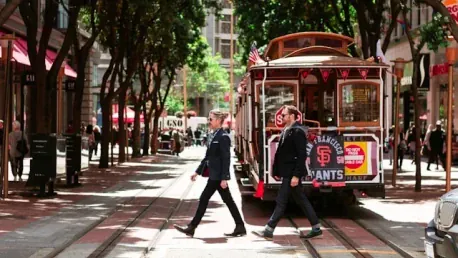In an era where urban mobility is becoming increasingly complex, artificial intelligence (AI) has emerged as a pivotal force in revolutionizing public transportation. This transformative technology not only redefines efficiency and safety but also significantly enhances passenger convenience. As cities grapple with growing populations and escalating traffic problems, AI offers potent solutions that optimize daily operations, anticipate maintenance needs, and elevate traveler experiences. Delving into the various facets of AI’s influence on public transit reveals promising advancements and notable challenges shaping the landscape of urban mobility.
Enhancing Operational Efficiency
Optimizing Routes and Schedules
One of AI’s most transformative capabilities in public transportation is its ability to optimize routes and schedules through sophisticated data analysis. By harnessing extensive datasets, AI can dynamically adjust resources to match demand, effectively reducing traffic congestion and improving transit efficiency. For example, AI algorithms analyze real-time traffic data and historical trends to predict peak travel times, enabling transit authorities to strategically deploy assets. This proactive resource management ensures that buses and trains run efficiently, resulting in shorter wait times and more reliable service for passengers.
Moreover, AI-powered tools can integrate various forms of public transportation, such as buses, trains, and rideshare services, into a seamless network. This integration allows for synchronized schedules, facilitating smoother transfers and minimizing delays. As a result, passengers experience a cohesive and efficient transit system, encouraging more people to choose public transportation over private vehicles. The combined impact of these advancements is a more efficient, environmentally friendly, and user-friendly urban transit network.
Predictive Maintenance Tools
AI also plays a crucial role in enhancing the maintenance of public transportation equipment through predictive maintenance tools. Instead of relying on routine checks or responding to breakdowns after they occur, transit authorities can employ AI to foresee potential equipment failures. By analyzing data from sensors embedded in vehicles and infrastructure, AI systems can predict when components are likely to fail, allowing for timely repairs and reducing the risk of unexpected malfunctions.
This approach not only ensures better upkeep of transportation assets but also significantly cuts down maintenance costs and minimizes service disruptions. Scheduled repairs based on AI insights can prevent severe problems, extending the lifespan of vehicles and infrastructure. As a result, public transportation systems can maintain higher levels of reliability and safety, ultimately benefiting passengers who depend on consistent and punctual service.
Improving Safety and Security
Autonomous Vehicles and Driverless Taxis
The introduction of AI in the form of autonomous vehicles is revolutionizing urban transportation, setting new standards for safety and efficiency. Companies like Baidu have launched driverless taxis in cities across China, showcasing the potential of AI-driven mobility solutions. These autonomous vehicles utilize advanced sensors, cameras, and algorithms to navigate busy streets, drastically reducing the likelihood of human error, which is a leading cause of traffic accidents. Consequently, the widespread adoption of driverless taxis could lead to safer roads and fewer casualties.
Furthermore, autonomous vehicles contribute to traffic optimization by maintaining consistent speeds and following optimal routes, thereby alleviating congestion. As these technologies advance, we can anticipate their integration into broader public transportation networks, offering an intelligent alternative to conventional commuting options. The deployment of autonomous buses and shuttles in urban areas could further enhance the efficacy of public transit systems, making them more reliable and appealing to commuters.
AI-Powered Surveillance Systems
Another significant advancement in public transportation safety comes from AI-powered surveillance systems. These sophisticated technologies enhance passenger security by swiftly detecting suspicious activities and alerting authorities in real-time. For instance, AI can analyze video feeds from surveillance cameras to identify unusual behaviors or potential threats, such as unattended bags or illegal activities. In New York City’s subway system, AI initiatives include firearm detection, which significantly boosts passenger safety by providing rapid responses to potential threats.
These AI-enabled systems can also assist in crowd management during peak hours, ensuring that platforms and vehicles do not become dangerously overcrowded. By foreseeing and addressing safety concerns before they escalate, AI-powered surveillance helps create a more secure and comfortable environment for transit users. This proactive approach to security not only deters criminal activities but also instills confidence in the public transportation system, encouraging higher ridership and greater satisfaction among passengers.
Enhancing Passenger Experience
Real-Time Updates and Personalized Recommendations
AI technologies significantly enhance the passenger experience by providing real-time updates on schedules and delays. Digital platforms powered by AI keep travelers informed about the status of their routes, helping them plan their commutes more effectively. For example, apps integrated with AI can instantly alert users to changes in bus or train schedules, enabling them to make alternative arrangements promptly. This level of immediacy and accuracy greatly enhances the convenience and reliability of public transportation.
Beyond just updates, AI also offers personalized travel recommendations based on individual user habits and preferences. By analyzing patterns in a commuter’s daily travel, AI systems can suggest optimal routes and modes of transport, reducing overall travel time and improving the user experience. Such personalized insights cater to the needs of each passenger, making public transit a more attractive option compared to private vehicles or rideshares.
Practical Applications in Public Transit Systems
Practical applications of AI in public transportation are already being implemented worldwide, yielding tangible benefits for commuters. Baidu’s Apollo Go robotaxi service, for instance, exemplifies how AI can seamlessly integrate into daily transit operations. This service offers users a hassle-free, efficient mode of transport without the need for human drivers, demonstrating AI’s potential to reshape urban mobility landscapes. Similarly, the Metropolitan Transportation Authority (MTA) in New York City employs AI-equipped drones to monitor buses, ensuring optimal route adherence and addressing issues in real-time.
These innovative applications illustrate AI’s capacity to revolutionize public transportation, making it smarter, safer, and more responsive to passenger needs. As AI technologies continue to advance, their integration into public transit systems promises to yield further improvements in efficiency, safety, and overall user satisfaction, shaping a future where urban transportation is more adaptable and reliable.
Addressing Challenges and Future Prospects
Privacy and Cybersecurity Concerns
While the benefits of AI in public transportation are evident, several challenges must be addressed to ensure its fair and effective deployment. Privacy concerns arise from the vast amounts of data collected by AI systems, which include sensitive information about passenger behavior and preferences. Ensuring that this data is handled responsibly and securely is crucial to maintaining public trust. Implementing robust data protection measures and adhering to stringent privacy regulations can help mitigate these concerns and foster greater confidence in AI-driven transit solutions.
Moreover, cybersecurity remains a significant challenge as AI systems become more integrated into public transportation. Protecting transportation infrastructure from cyber threats is essential to prevent potential disruptions and ensure the safety of passengers. Collaborative efforts among stakeholders, including government agencies, technology providers, and transit authorities, are vital in developing comprehensive security frameworks to safeguard AI applications in public transportation.
Ensuring Fair Deployment and Investment Needs
In today’s world, urban mobility is becoming more complex, and artificial intelligence (AI) has become a crucial force in transforming public transportation. This innovative technology not only enhances efficiency and safety but also significantly improves passenger convenience. As cities face growing populations and increasing traffic issues, AI provides powerful solutions to optimize daily operations, predict maintenance needs, and improve traveler experiences. Exploring the various aspects of AI’s impact on public transit uncovers promising advancements and notable challenges that are shaping urban mobility. For instance, AI-powered systems can manage traffic flows more effectively by analyzing real-time data, thus reducing congestion and improving travel times. Moreover, AI can predict when maintenance is needed, preventing breakdowns and ensuring that vehicles are always in top condition. However, the integration of AI in public transportation also presents challenges, such as the need for significant investment and the potential for job displacement. As cities continue to evolve, the role of AI in public transportation will undoubtedly become even more significant, offering both exciting opportunities and complex obstacles to navigate.









